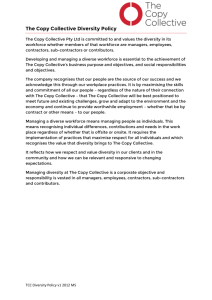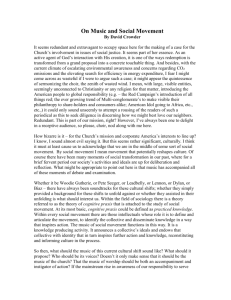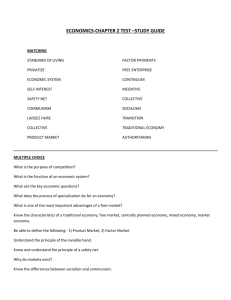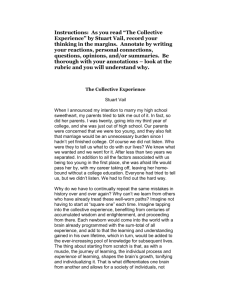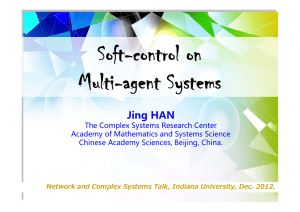learning
advertisement
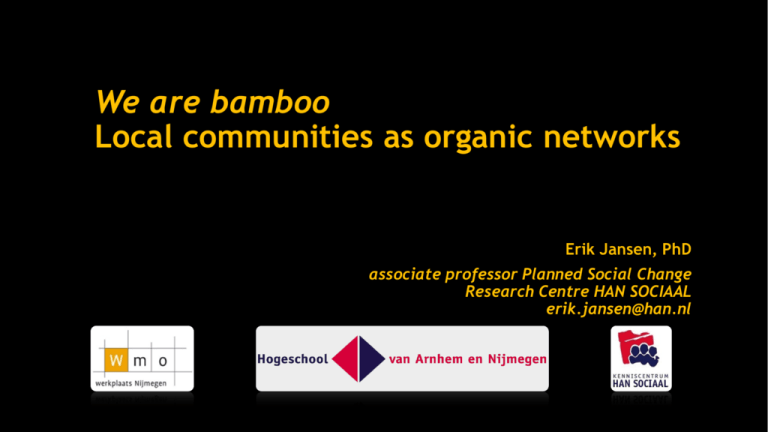
We are bamboo Local communities as organic networks Erik Jansen, PhD associate professor Planned Social Change Research Centre HAN SOCIAAL erik.jansen@han.nl Social transformation as collection of network problems Network problem = “a large number of parties is involved, with diversity in values, perspectives and interests, for which power and responsibilities are fragmented, without a single actor being able to enforce an all-encompassing solving intervention. In these problems both the solving strategy and analysis of the problem are contested: different actors often answer the question ‘what exactly is the problem’, differently, often contradictorily.” Van der Steen, Peeters & Van Twist, 2010, p. 3 Tradional organising strategies inadequate for network problems Old strategies: Simplifying the problem New strategies: Accept complexity and learn to deal with it and Employ collective intelligence Bamboo Rizome as metaphor (Deleuze en Guattari, 1976) • Horizontally branched root structure not reducible to a single branch or surface plant • Keeps forming new connections • Extracting a single plant does not kill the organism • No beginning and no ending • Can at most be controlled, continues to spread Instead of viewing the town district/ neighborhood as structured organisation see it as a fine-grained web of relations between individuals. If clusters of individuals display much mutual contact, they yield communities. District A different concept of community • Community is generally regarded (or treated) as referring to groups • Network theory brings about a definition in terms of bottom-up clustering Community as GROUP • Based on common characteristics • Closed concept • Tends to be static • Capitalizes on mechanisms of exclusion vs inclusion • Entity Community as CLUSTER • Based on proximity and interrelations • Open concept • Evolves dynamically • Capitalizes on binding forces • Organisational pattern How to govern in a living network? • Facilitate formation of connections instead of centralized steering • Self-determination of individuals: seek mutual perspective or interests • Process is essential: trust! • Local culture and shared values where ideas flow freely and transparantly… • …and lead to collective action Take care of the soil where roots can grow What flows through connections? Pentland (2014): collective intelligence grows by way of reverberation of ideas in networks 1. Idea flow (directionality): exploration in the network for new ideas 2. Engagement (binding force): direct, positive contacts between individual people leads to cooperative behavior (Spread of) learning in networks: social learning (De Laat, 2014; Engestrøm, 2007) Towards a learning Civil Society… Social innovation in neighborhoods and districts: - - Professionals and citizens jointly forming the organism of the living network (Rhizome) … Organized as emergent (bottom-up) Communities of Practice (learning networks)… In which they collaboratively develop critical, reflective practices and are being addressed in their personal learning capacity … Based on substantial dialogue (public deliberation)… Matched with collective action… Supported by social workers / community developers / social support teams. This holds for organisations as well - A living entity What is the binding force? Not your position but your contribution is what counts - Everyone has her function within the whole Knowledge circulation: ideas as “juices of life” - Inniovation and change based on: 1. Expertise 2. Enthousiasm en passion 3. Inspiration 4. Idealism The practitioner in the bambooforest New role for practitioners: 1. Reasoning from the common GOAL of the organisation 2. Be proactive 3. Experiment 4. Be critical 5. Knowledge multiplies if you share it Above all: Value others for what they contribute, not for their position Middle managers in the bambooforest Facilitate LEARNING PROCESSES (Stam et al., 2015): 1. Learning from experience 2. Learning from uncertainty 3. Learning bottom-up by explicitizing practices 4. Learning from tension and conflict 5. Learning by exploring boundaries 6. Learning from dialogue 7. Learning in community Executives in the bambooforest New roles for leadership: 1. Cultivate curiosity: create opportunities to form cross-organisational connections based on common interests 2. Create space for learning and initiative: enable the formation and maintenance of new connections Above all: Let the forest grow and cherish collateral benefits! Take the bambooforest as your reference and not its separate plants Grow by learning Thank you for your attention!



